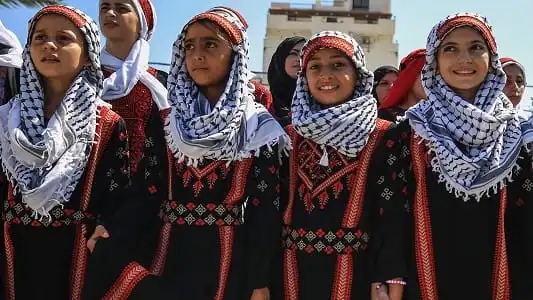Palestine’s traditional garments are a stunning manifestation of the country’s culture, which is rich in history, customs, and attention to detail. The needlework, known as tatriz, is abundant on the garments.
However, there are a number of variables that determine the specific style, including geographical location, socioeconomic class, marital status, and historical era.
Traditional dress of men
Palestinian men’s traditional attire included an undergarment, as kaftan, loose-fitting trousers, an overgarment, a belt, and a headpiece. Long and loose, the kaftan was the traditional Palestinian garment. The top was snug, but it loosened up a bit at the bottom.
The qamis, long cotton or any fine wool shirt worn under the kaftan, was often white or beige in color. He also wore a pair of long, baggy trousers called sirwal or shirwal, which were typically black, dark blue, or white and knotted at their waist with a chain or rope.
The jubba, a short garment having long, wide arms, was a common outerwear item for Palestinian males. The salta was similar to the jubba, but had shorter sleeves. The abaya, a type of cloak, was also commonly worn as an outer layer.
Over the jubba, celebratory wearers would don this exquisite cloth and color-blocked shirt. Men typically favored the shorter bisht abaya with long sleeves, though both lengths were available.
Accessories
Different types of headdresses were worn with each ensemble. The kuffiyah, a black & white checkered cloth, became a symbol of Palestine and the country’s humble way of life. Its primary use was to shield the wearer’s head & neck from the sun.
Added to the kuffiyah, a laffah, a scarf made of silk or cotton, is worn on the head. This is the tarbush. Palestinian males also wore the hata, a huge square made from cloth secured with a broad stiff black chord named the agal, and the traditional taqiyyah, a little cotton skull cap worn underneath.
Palestinian men accessorized their outfits with narrow belts known as hizam and thicker belts known as lavandi. Until the middle of the twentieth century, most Palestinian men also didn’t wear shoes at all.
Traditional dress for women
One of the earliest examples of traditional Palestinian women’s dress is a four-piece ensemble consisting of a wraparound fabric, cloak, headgear, and shawl. The izar, a wrap made of white cotton or linen, was worn around the body. The izar was eventually supplanted by other garments.
The substitute, khabara, was made of silk and was available in a rainbow of hues. This garment was used by women to hide their shoulders or flared out at ankles and hem. Women also wore a cloak named a malliaia, made of silk and dyed to match their khabaras. In addition, they had a burnous, a hooded garment that reached only to the hips.
Over time, they began to wear thobes, which are similar to modern-day robes. The traditional Palestinian thobe consisted of a long, baggy dress with long sleeves. Where in Palestine a given robe was made had an impact on its shape, pattern, and embroidery.
Palestinian ladies wore a variety of coats over their thobes. Among these were the taqsireh, jubbeh, and jillayeh. The provenance of each one also influenced the uniqueness of its design and ornamentation.
Accessories
In addition, they still wore veils and headscarves to hide their identities and appearances. Again, their patterns varied depending on their place of origin in Palestine. However, the bushnika, a floral-patterned scarf, was among the most common. Most women wore a wool or silk shawl over their bushnika.
A red hat similar to the fez known as a tarbush was also commonly seen on married women. Coins and other embellishments adorned it. Women who were not married often wore head coverings resembling bonnets. However, the bushnika was typically the crowd favorite.
Jewelry, especially silver pieces, played a significant role in the Palestinian women’s wardrobe with coins and other accessories. Jewelry of all kinds, from necklaces to bracelets to nose rings to anklets, were included. Even though some were brought in from Egypt and Syria, highly accomplished Palestinian silversmiths were also capable of creating incredibly stunning pieces of art.
While some items were used only for decoration, others were carried around as good luck charms. Some of these ornaments were large silver bands, while others were adorned with chains and coins. Gold jewelry, however, first appeared in Palestinian marketplaces in the early twentieth century.
After years of using silver, women rebelled and switched to gold. Unfortunately, many Palestinian women of 1948 exodus were compelled to sell family jewels in order to live. It is unusual to come across an antique piece of Palestinian silver jewelry today.
Conclusion
Traditional Palestinian dress retains some of its distinctive characteristics even now, especially in the attire worn by Palestinian women. A person’s origins can easily be recognized from the colors they wear in Palestine.


